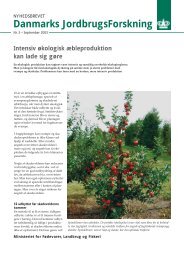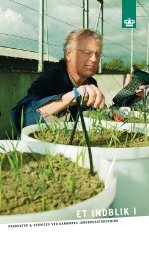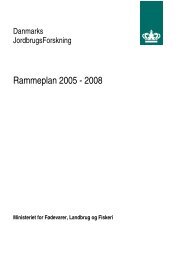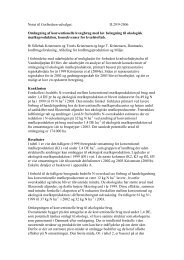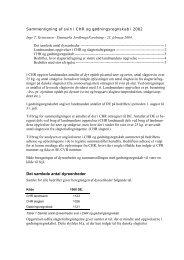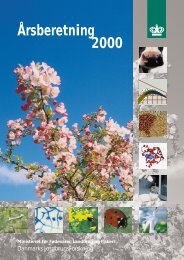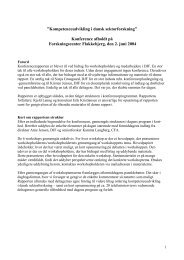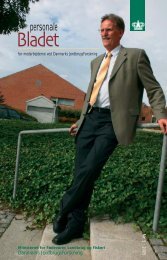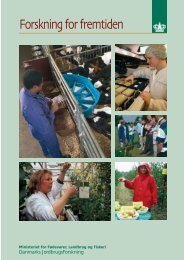Reproduction performances and conditions of group-housed non ...
Reproduction performances and conditions of group-housed non ...
Reproduction performances and conditions of group-housed non ...
Create successful ePaper yourself
Turn your PDF publications into a flip-book with our unique Google optimized e-Paper software.
- Paper I -<br />
pregnancy failure. There is a negative correlation between feed intake during gestation <strong>and</strong><br />
feed intake during lactation, for which reason very high feed intake during gestation may<br />
lead to low energy intake in lactation <strong>and</strong> thereby perhaps a lower litter size <strong>and</strong> pregnancy<br />
rate in the following cyclus. However, how high the feed intake in pregnancy shall be be-<br />
fore reproduction in the next cyclus is impaired, is not possible to say.<br />
5. Discussion<br />
The results reviewed do not provide a clear picture <strong>of</strong> the relation between energy supply<br />
<strong>and</strong> reproduction in female pigs because the results are <strong>of</strong>ten inconsistent. It is therefore<br />
difficult to draw unambiguous conclusions, however, some lines can be drawn.<br />
First <strong>of</strong> all, it seems that the reproduction performance <strong>of</strong> gilts in general is more influenced<br />
by energy supply than the reproduction performance <strong>of</strong> the sow. There are indications that<br />
ovulation rate <strong>and</strong> thereby litter size can be impaired in gilts if they are fed restricted (≤25<br />
MJ ME day -1 ) before mating. When it comes to the sow, the picture is much less clear.<br />
Energy intake from weaning to mating seems to have little influence on litter size although<br />
moderate energy intake (37 compared to 74 MJ ME day -1 ) did impair litter size in sows that<br />
experienced severe weight loss (39 kg) during lactation in one study (Baidoo et al., 1992).<br />
There are indications that litter size in gilts can be reduced if they are fed moderate (≥31 MJ<br />
ME day -1 ) compared to low (18-23 MJ ME day -1 ) level <strong>of</strong> energy the first three days after<br />
mating. Whether this is also the case for the sow has not been confirmed. The number <strong>of</strong><br />
born piglets per litter seems to be highly resistant to even starvation in early pregnancy in<br />
some female pigs, however, there are indications that very low energy intake (≤13 MJ ME<br />
day -1 ) the first four weeks in pregnancy may impair litter size. Less restricted energy intake<br />
(21 MJ ME day -1 ) in early pregnancy may also reduce the litter size in sows fed very restricted<br />
(36 MJ ME day -1 ) during lactation. Pregnancy rate in gilts can apparently be reduced<br />
if they are fed very restricted (≤18 MJ ME day -1 ) the first 35 days <strong>of</strong> pregnancy.<br />
Whether this is the same for sows is not possible to conclude, however, it seems that low<br />
energy intake for several successive parities can increase the risk <strong>of</strong> being culled as a consequence<br />
<strong>of</strong> not being pregnant. Furthermore, it cannot be excluded that high feed intake<br />
during pregnancy reduces voluntary feed intake in lactation <strong>and</strong> thereby reduce the litter<br />
size in the following cyclus.<br />
The existence <strong>of</strong> a relation between energy intake <strong>and</strong> litter size <strong>and</strong> pregnancy rate is further<br />
supported by studies showing an effect <strong>of</strong> energy related hormones, e.g. insulin <strong>and</strong><br />
IGF-1, on the hormonal control <strong>of</strong> litter size <strong>and</strong> pregnancy. The increase in ovulation rate<br />
seen in gilts as a consequence <strong>of</strong> flushing before oestrus is thus believed to be mediated<br />
through an increase in insulin <strong>and</strong> IGF-1 levels followed by an increase in plasma levels <strong>of</strong><br />
38




